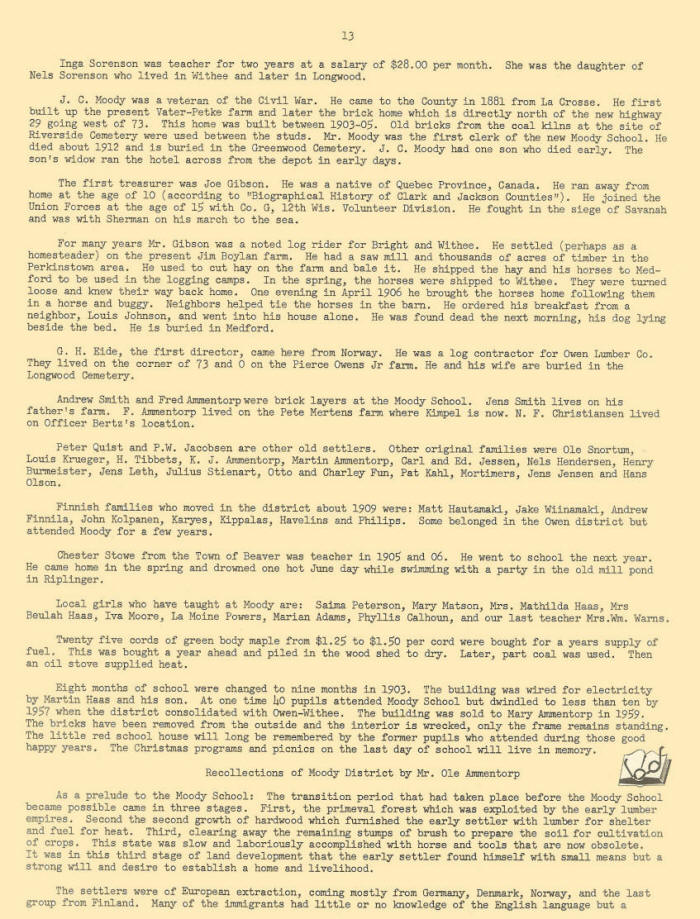|
[Memory
Trails Index]
Transcription
Janet Schwarze
Inga Sorenson was
teacher for two years at a salary of $28.00 per month. She was the daughter of
Nels Sorenson who lived in Withee and later in Longwood.
J. C. Moody was a veteran of the Civil War. He came to the County in 1881 from
La Crosse. He first built up the present Vater-Petke farm and later the brick
home which is directly north of the new highway 29 going west of 73. This home
was built between 1903-05. Old bricks from the coal lcLlns at the site of
Riverside Cemetery were used between the studs. Mr. Moody was the first clerk of
the new Moody School. He died about 1912 and is buried in the Greenwood
Cemetery. J. C. Moody had one son who died early. The son’s widow ran the hotel
across from the depot in early days.
The first treasurer was Joe Gibson. He was a native of Quebec Province, Canada.
He ran away from home at the age of 10 (according to “Biographical History of
Clark and Jackson Counties”). He joined the Union Forces at the age of 15 with
Co. G, 12th Wis. Volunteer Division. He fought in the siege of Savannah and was
with Sherman on his march to the sea.
For many years Mr. Gibson was a noted log rider for Bright and Withee. He
settled (perhaps as a homesteader) on the present Jim Boylan farm. He had a saw
mill and thousands of acres of timber in the Perkinstown area. He used to cut
hay on the farm and bale it. He shipped the hay and his horses to Medford to be
used in the logging camps. In the spring, the horses were shipped to Withee.
They were turned loose and imew their way back home. One evening in April 1906
he brought the horses home following them in a horse and buggy.
Neighbors helped tie the
horses in the harm. He ordered his breakfast from a neighbor, Louis Johnson, and
went into his house alone. He was found dead the next morning, his dog lying
beside the bed. He is buried in Medford.
G. H. Eide, the first director, cane here from Norway. He was a log contractor
for Owen Lumber Co. They lived on the corner of 73 and 0 on the Pierce Owens Jr.
farm. He and his wife are buried in the Longwood Cemetery.
Andrew Smith and Fred Ammentorp were brick layers at the Moody School. Jens
Smith lives on his father’s farm. F. Ammentorp lived cm the Pete Mertens farm
where Kimpel is now. N. F. Christiansen lived on Officer Bertz’s location.
Peter Quist and P. W. Jacobsen are other old settlers. Other original families
were Ole Snortum, Louis Krueger, H. Tibbets, K. J. Ammentorp, Martin Ammentorp,
Carl and Ed. Jessen, Nels Hendersen, Henry Burmeister, Jens Leth, Julius
Stienart, Otto and Charley Fun, Pat Kahi, Mortimers, Jens Jensen and Hans Olson.
Finnish families who moved in the district about 1909 were: Matt Hautamaki, Jake
Wiinanaki, Andrew Finnila, John Kolpanem, Karyes, Kippalas, Havelins and
Philips. Some belonged in the Owen district but attended Moody for a few years.
Chester Stowe from the Town of Beaver was teacher in 1905 and 06. He went to
school the next year. He cane home in the spring and drowned one hot June day
while swimming with a party in the old mill pond in Riplinger.
Local girls who have taught at Moody are: Saima Peterson, Mary Matson, Mrs.
Mathilda Haas, Mrs Beuiah Haas, Iva Moore, La Moine Powers, Marian Adams,
Phyllis Calhoun, and our last teacher Mrs. Wm. Warns.
Twenty five cords of green body maple from $1.25 to $1.50 per cord were bought
for a years supply of fuel. This was bought a year ahead and piled in the wood
shed to dry. Later, part coal was used. Then an oil stove supplied heat.
Eight months of school were changed to nine months in 1903. The building was
wired for electricity by Martin Haas and his son. At one tine Lo pupils attended
Moody School but dwindled to less than ten by 1957 when the district
consolidated with Owen-Withee. The building was sold to Mary Ammentorp in 1959.
The bricks have been removed from the outside and the interior is wrecked, only
the frame remains standing. The little red school house will long be remembered
by the former pupils who attended during those good happy years. The Christmas
programs and picnics on the last day of school will live in memory.
Recollections of Moody District by Mr. Ole Ammentorp
As a prelude to the Moody School: The transition period that had taken place
before the Moody School became possible came in three stages. First, the
primeval forest which was exploited by the early lumber empires. Second the
second growth of hardwood which furnished the early settler with lumber for
shelter and fuel for heat. Third, clearing away the remaining stumps of brush to
prepare the soil for cultivation of crops. This state was slow and laboriously
accomplished with horse and tools that are now obsolete. It was in this third
stage of land development that the early settler found himself with small means
but a strong will and desire to establish a home and livelihood.
The settlers were of European extraction, coming mostly from Germany, Denmark,
Norway, and the last group from Finland. Many of the immigrants had little or no
knowledge of the English language but a
[Next]
[Memory
Trails Index]
|
